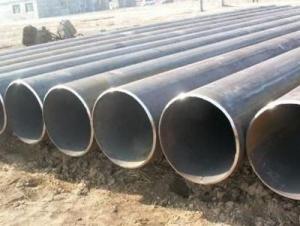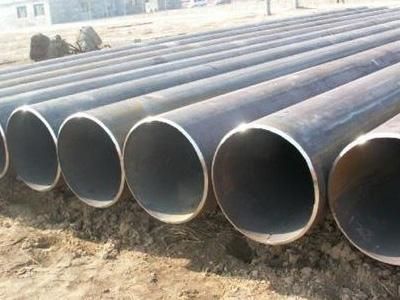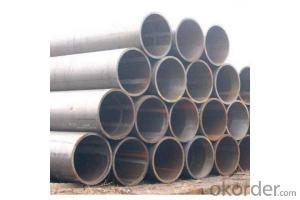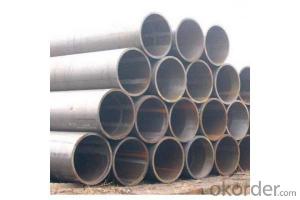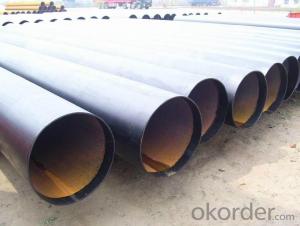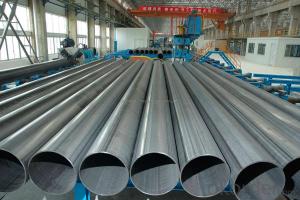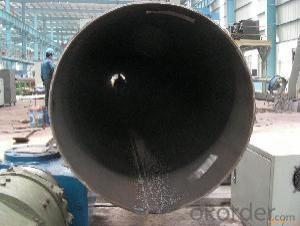LSAW SSAW CARBON STEEL PIPE ASTM API PSL1 PSL2 PIPE LINE 18''
- Loading Port:
- Tianjin
- Payment Terms:
- TT OR LC
- Min Order Qty:
- 1 m.t.
- Supply Capability:
- 3000 m.t./month
OKorder Service Pledge
OKorder Financial Service
You Might Also Like
Packaging & Delivery
Packaging Detail: | Normal exporting packing,in container or bulk vessel or as per clients' request |
Delivery Detail: | 2 months after confimed contract |
Specifications
Large Diameter API 5L X70 PSL2 LSAW Steel Pipe
Grade: X42, X46, X50, X52, X60, B, C
OD: 1.5"-28"
WT: SCH10-SCH160
Large Diameter API 5L X70 PSL2 LSAW Steel Pipe
Specifications:
u Standard: API 5L
u Grade: B, C, X42, X46, X50, X52, X56, X60, X65, X70, X80
u OD: 1.5"-28"
u WT: SCH10-SCH160
u Length: 5-12m
u Ends Finish: plain end, bevel end, grooved end
u Surface Treatment: bare, black varnished, oiled finish, red color, anti-corrosion, 3PE, FBE or epoxy coating
u Technique: hot rolled or cold drawn
u Application: api 5l steel pipe for conveying oil, water, gas
u Invoicing: based on theoretical weight or actual weight
u Payment Terms: L/C at sight, T/T or Western Union
u Trade Terms: FOB, CFR, CIF
u Certification: ABS manufacturing assessment, ABS design assessment, API 5CT, API 5L, DNV manufacturer certificate, ISO9001 quality management system certificate, ISO14001 environment management system certificate, GB/T28001 occupational health and safety management system certificate, A1 class manufacturing license of special equipment certificate, CCS, GL, LR, SGS, TüV, PDE
- Q: How do you prevent freezing in steel pipes during cold weather?
- One effective way to prevent freezing in steel pipes during cold weather is to insulate the pipes. This can be done by applying foam insulation sleeves or wraps around the pipes. Additionally, ensuring that the pipes are properly sealed and any gaps or cracks are sealed can help prevent cold air from reaching the pipes. It is also important to keep the pipes warm by maintaining a consistent temperature in the surrounding area. This can be achieved by using a space heater or by allowing warm air to circulate around the pipes.
- Q: What are the specific differences between flexible pipes and rigid pipes?
- Structurally:A rigid waterproof sleeve is welded with a water stop ring outside the steel pipe;The flexible waterproof casing pipe is welded on the outside of the 3 side wing ring, 4 screw buckle, inside a welding piece with a rubber ring, the outside and do a flange, with 4 double head bolt, welding a steel pipe, the pipe installed, the flange is installed. The screw fastening, tightening the apron is bigger, more Water Leakage, generally in the waterproof requirements of relatively high places, such as the pool of water.
- Q: How do you determine the weight per foot of a steel pipe?
- To determine the weight per foot of a steel pipe, you need to consider two main factors: the thickness and the diameter of the pipe. First, you need to measure the outer diameter (OD) and the wall thickness (WT) of the pipe using a caliper or a measuring tape. Once you have these measurements, you can calculate the inner diameter (ID) by subtracting twice the wall thickness from the outer diameter (ID = OD - 2 * WT). Next, use the formula for the cross-sectional area of a pipe (A = π * (OD^2 - ID^2) / 4) to calculate the cross-sectional area. Finally, multiply the cross-sectional area by the density of the steel, which is typically around 490 pounds per cubic foot, to determine the weight per foot of the steel pipe. Weight per foot (WPF) = A * 490 It's important to note that this calculation provides an estimate of the weight per foot, as manufacturing tolerances and slight variations in the density of the steel may affect the actual weight. Therefore, it is recommended to use this calculation as a guide and consult the manufacturer's specifications for more precise information.
- Q: What are the different methods of pipe coating for steel pipes?
- There are several different methods of pipe coating for steel pipes, each with its own advantages and applications. One common method is fusion bonded epoxy (FBE) coating. This involves heating the steel pipe and applying a thermosetting powder that melts and adheres to the surface, creating a strong and durable coating. FBE coating provides excellent corrosion protection and is commonly used in the oil and gas industry. Another method is liquid epoxy coating. This involves applying a liquid epoxy resin to the surface of the steel pipe, which then cures and forms a protective barrier. Liquid epoxy coating is often used for smaller diameter pipes and provides good chemical resistance. Polyethylene (PE) coating is another popular method, particularly for pipelines that will be buried underground. PE coating involves wrapping the steel pipe with a layer of polyethylene, which provides excellent resistance to water, chemicals, and abrasion. Polyurethane (PU) coating is another option, offering a high level of chemical resistance and flexibility. It is typically used for offshore applications and in environments with extreme temperatures. Other methods of pipe coating include coal tar enamel (CTE) coating, which provides excellent resistance to water and chemicals, and concrete weight coating, which adds weight to the pipe to ensure stability in underwater or subsea applications. In summary, the different methods of pipe coating for steel pipes include fusion bonded epoxy (FBE), liquid epoxy, polyethylene (PE), polyurethane (PU), coal tar enamel (CTE), and concrete weight coating. The choice of coating method depends on the specific requirements of the application, such as corrosion protection, chemical resistance, or stability.
- Q: What is the maximum allowable stress for steel pipes?
- The maximum allowable stress for steel pipes depends on various factors such as the grade of steel, diameter, wall thickness, and the intended application. It is typically determined by industry standards and codes, such as the American Society of Mechanical Engineers (ASME) Boiler and Pressure Vessel Code. Therefore, there is no one-size-fits-all answer to this question.
- Q: How long are the seamless tubes? Are they six meters long?
- 6 meters of a root in general need to be customized, seamless tubes are mostly seven meters above the variable foot
- Q: What are the specifications for steel pipes used in high-pressure applications?
- The specifications for steel pipes used in high-pressure applications typically include factors such as high tensile strength, corrosion resistance, and the ability to withstand extreme temperatures and pressures. These pipes are usually made from alloy or carbon steel with specific dimensional requirements, such as minimum wall thickness and diameter, to ensure their durability and safety under high-pressure conditions. Additionally, they may need to comply with industry standards and regulations, such as ASTM or ASME specifications, to ensure their quality and suitability for high-pressure applications.
- Q: What is the difference between hot-dipped galvanized and electro-galvanized steel pipes?
- Hot-dipped galvanized and electro-galvanized steel pipes are both types of steel pipes that have undergone a galvanization process to protect them from corrosion. However, there are some key differences between the two processes. Hot-dipped galvanized steel pipes are immersed in a molten zinc bath, which results in a thick coating of zinc being applied to the surface of the steel. This process creates a durable and long-lasting corrosion-resistant barrier. The thickness of the zinc coating can vary, but it is generally thicker than that of electro-galvanized steel pipes. On the other hand, electro-galvanized steel pipes are coated with a thin layer of zinc using an electroplating process. This process involves passing an electric current through the steel pipes while they are immersed in a zinc solution. The zinc particles are then deposited onto the surface of the steel, creating a thin and uniform protective barrier. One of the main differences between these two processes is the thickness of the zinc coating. Hot-dipped galvanized steel pipes have a thicker and more robust coating, making them more suitable for applications in harsh environments or where the pipes will be exposed to corrosive substances. Another difference is the appearance of the pipes. Hot-dipped galvanized steel pipes typically have a dull grayish finish, while electro-galvanized steel pipes have a smoother and more polished appearance. In terms of cost, electro-galvanized steel pipes are generally more economical compared to hot-dipped galvanized steel pipes. This is because the electroplating process is less labor-intensive and requires less zinc. Overall, the choice between hot-dipped galvanized and electro-galvanized steel pipes depends on the specific application and the level of corrosion resistance required. Hot-dipped galvanized steel pipes are typically used in more demanding environments, while electro-galvanized steel pipes are suitable for less corrosive applications where cost-efficiency is a priority.
- Q: Can steel pipes be used for conveying solid materials?
- Yes, steel pipes can be used for conveying solid materials. Steel pipes are known for their durability and strength, making them suitable for transporting various solid materials such as ores, grains, coal, and construction materials. The smooth interior of steel pipes allows for efficient flow and minimal friction, making them a preferred choice in industries like mining, agriculture, and construction.
- Q: What are the different methods of lining steel pipes?
- There exist various techniques for lining steel pipes, each possessing distinct advantages and applications. Some popular methods comprise: 1. Cement Mortar Lining: This technique entails the application of a cement mortar layer onto the inner surface of the steel pipe. Cement mortar offers outstanding protection against corrosion and grants smoothness to the pipe, consequently diminishing friction and enhancing flow rates. It finds common usage in water supply systems and sewage treatment plants. 2. Polyethylene (PE) Lining: PE lining necessitates the insertion of a polyethylene tube into the steel pipe. Typically, the tube is heat fused or mechanically connected to the steel pipe, resulting in a seamless and corrosion-resistant lining. PE lining is commonly employed in gas transmission and distribution pipelines. 3. Epoxy Lining: Epoxy lining involves the application of an epoxy resin onto the inner surface of the steel pipe. Epoxy coatings exhibit exceptional resistance to corrosion, abrasion, and chemicals, thereby making them suitable for a variety of applications such as oil and gas pipelines, water treatment, and industrial processes. 4. Trenchless Pipe Lining: This method serves to rehabilitate existing steel pipes without the requirement of excavation. It encompasses the insertion of a liner or resin-coated fabric into the existing pipe, which is subsequently inflated and cured to form a new lining. Trenchless pipe lining is commonly utilized for sewer and water main rehabilitation. 5. Polyurethane (PU) Lining: PU lining involves the spraying or pouring of a polyurethane coating onto the inner surface of the steel pipe. Polyurethane linings deliver excellent resistance to abrasion, impact, and chemicals, thereby suiting applications in mining, slurry pipelines, and wastewater treatment. These represent merely a few of the numerous methods accessible for lining steel pipes. The selection of a lining approach is contingent upon factors such as the intended application, the environment, and the desired level of corrosion resistance and durability.
Send your message to us
LSAW SSAW CARBON STEEL PIPE ASTM API PSL1 PSL2 PIPE LINE 18''
- Loading Port:
- Tianjin
- Payment Terms:
- TT OR LC
- Min Order Qty:
- 1 m.t.
- Supply Capability:
- 3000 m.t./month
OKorder Service Pledge
OKorder Financial Service
Similar products
Hot products
Hot Searches
Related keywords
